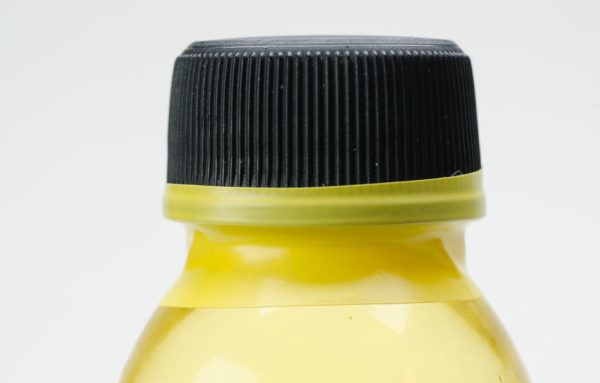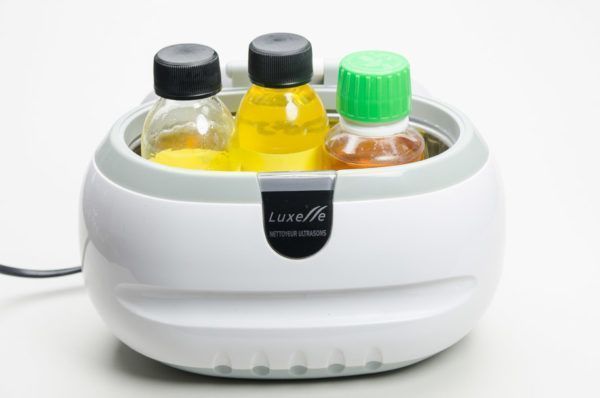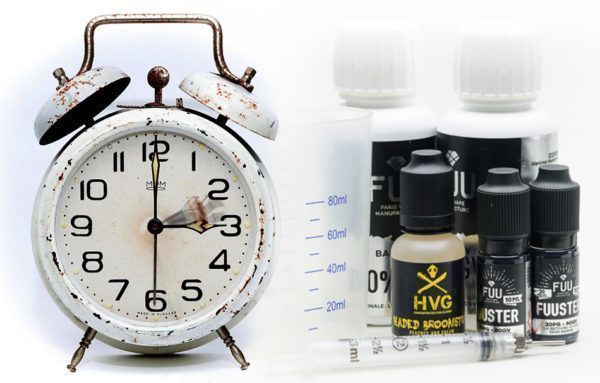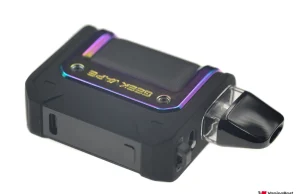The benefit of steeping
 Obviously, when you have just made a liquid, it is extremely tempting to vape it straight away. After all, you didn’t make it just to spend long winter evenings looking at the bottle. The problem is, a lot of liquids are like fine wine, they improve with age. Not quite as much as wine, nonetheless, I doubt that a liquid made this year would be considered a great vintage in 2080. It will have expired well before that. However, as a general rule, it can only benefit from having been allowed to mature for a few days to a few weeks.
Obviously, when you have just made a liquid, it is extremely tempting to vape it straight away. After all, you didn’t make it just to spend long winter evenings looking at the bottle. The problem is, a lot of liquids are like fine wine, they improve with age. Not quite as much as wine, nonetheless, I doubt that a liquid made this year would be considered a great vintage in 2080. It will have expired well before that. However, as a general rule, it can only benefit from having been allowed to mature for a few days to a few weeks.
In a freshly prepared liquid, some flavours may be too strong, others too weak, and some have not yet achieved their exact flavour. During the steeping process, each flavour molecule is diluted in the base, and the flavours will react with one another. These chemical reactions are slow and will require several days, or even several weeks for some to reach completion. The liquid will only develop its definitive flavour at the end of this maturation period.
Also, steeping does not only apply to DIY liquids, ready-to-vape liquids are also concerned. Some manufacturers allow a period of time between manufacturing a bottle and shipping it to retail outlets, but, as a general rule, the shipping, warehousing, and in-store storage time before sale is enough. However, gourmet liquids with longer steeping processes will benefit from allowing bottles to mature for a few more weeks before consumption. 
When we talk about flavours in relation to the bottles used in DIY liquids, the term is not quite accurate. The flavours used are not pure but rather pre-diluted, they would be too strong otherwise. Pure flavours are used in very small amounts, very difficult to dose without the right equipment. For this reason, they are sold in diluted form, hence the term concentrate. Too concentrated to be vaped directly, but diluted nonetheless.
As such, traces of solvents or other substances may remain and need to evaporate for the flavour to be rendered fully, as with perfumes for example. The time required for all these operations varies depending on the flavours, the process used to extract them, reactions between flavours, and how steeping is carried out.
How should you steep a liquid?
How should you steep a liquid? The answer is quite simple: by doing nothing. The most straightforward and most reliable method, that is the easiest to reproduce and safest for liquids, is to leave them at room temperature in a firmly sealed bottle stored in a dark place.

In a firmly sealed bottle, to prevent oxidation. Leaving a bottle of e-liquid for one week will dispel all of the flavour. Air contains oxygen, which oxidises flavours and causes them to lose all of their intensity.
On the other hand, it can be useful to leave the bottle open for an hour or two after making your mixture, to allow any solvents to evaporate freely. Even so, some people recommend replenishing the air in the bottle from time to time during the steeping process by opening the cap for one minute every few days. I have never noticed any difference myself, but why not? In a dark place, because flavours are sensitive to ultraviolet light. Not as much as nicotine, but to a degree nonetheless. It’s not too difficult, simply place the bottle in a cupboard, drawer, box, or use opaque bottles, there is no shortage of options. However, remember to always place your bottles out of the reach of children and pets, particularly if they contain nicotine. Store them with your boosters, which you obviously keep beyond reach because you are a sensible person.
Finally, at room temperature, which is true up to a point. Steeping is a phase in which the e-liquid matures and chemical reactions occur between the base and the flavours, and between the flavours. Heat accelerates chemical reactions, so it will accelerate the steeping process. Boiling your liquids is obviously out of the question, but steeping can be accelerated with a temperature of not more than 40°C. In this way, you can halve the steeping time by placing bottles at the right distance from a radiator for example in the wintertime, or behind a computer fan. In any case, make sure that your liquids do not exceed 40°C. And yes, at room temperature, the steeping process takes longer, but it still involves the least risk, and you simply need to prepare your liquids a little more in advance.
How should you not steep a liquid?
You may read or hear about particular methods for speeding up the steeping process. For example, leaving bottles in a car in the sun in the summertime. Apart from the fact that the temperature can reach 50°C, this method is especially unpredictable, uncontrolled, and impossible to reproduce consistently. The same applies for zapping in a microwave, which is either useless or harmful depending on the time and the power used. It might work, but you are just as likely to ruin your liquid.  Ultrasonic baths are also sometimes suggested, with the molecular agitation in the bath supposed to have the same accelerating effect on chemical reactions as heat, but without the risks. I have tried this option and have never noticed any difference from standard steeping. Maybe it needs to be left for longer, maybe the effect varies depending on the liquids, maybe a higher-power and more temperate bath is needed, unless it is quite simply useless.
Ultrasonic baths are also sometimes suggested, with the molecular agitation in the bath supposed to have the same accelerating effect on chemical reactions as heat, but without the risks. I have tried this option and have never noticed any difference from standard steeping. Maybe it needs to be left for longer, maybe the effect varies depending on the liquids, maybe a higher-power and more temperate bath is needed, unless it is quite simply useless.
Anyhow, this method does not appear to be able to damage your creations, at least with small, low-power baths, so there’s no harm in trying. In any case, you can use the bath to clean your gear, and small ones are available for as little as €20, so you can give it a try if you have one. Stirring can also accelerate the steeping process.
Forget about placing bottles in your washing machine using the spin programme, acting as a centrifuge, there is no need. On the other hand, laboratory stirrers, with a magnet rotating rapidly in the bottle, can reduce the steeping time, and you can throw one together for €10 — tutorials can be found on YouTube. As for the ultrasound bath, it is difficult to measure the exact impact on the steeping time of each liquid, but it also does not involve any risk for the liquids.
To steep or not to steep?
The big question remains in relation to the steeping time, a critical factor if the raging discussions among DIY enthusiasts on social media are anything to go by. And, hypothetically, there is no categorical and definitive answer that we can give to this question. To give an initial idea, the steeping time is about
- 2 to 7 days for single and fruity flavours
- 7 to 14 days for complex recipes
- 14 to 30 days for gourmet recipes
- 30 to 60 days for “classic” recipes

The most important thing to remember is that there is no one standard, and that there will never be an absolute answer to the question.
Firstly, because it depends on each liquid, and each recipe changes over time at its own pace. There are of course some trends depending on the types of flavours, but these mere trends are in no way dogmatic. Second, steeping has been defined as the time required for a liquid to be at its best, but the concept itself is entirely subjective. The majority of people will prefer steeped liquid, and will find it more balanced, cleaner and more harmonious after steeping than straight after production.
This does not imply that you are among this majority, and you may prefer your liquid without steeping! In sum, take the standard steeping time as the period of time that you will statistically have to wait before you can enjoy your liquid to the full. Just like for some wines, some liquids will be more enjoyable young. Taste regularly, as the days pass, to find the steeping time that you prefer, and you will have your answer for that particularly liquid. Vaping is a matter of taste, and your tastes are not in any rules or any chart.
To find out more…
We have prepared a series of articles examining DIY liquids:
- If it all seems like too much effort, which is understandable, you can opt for ready-to-use packs. We explain it all in detail (without taking up too much of your time).
- Since the TPD was transposed into French legislation, e-liquids sold throughout the country are restricted to 10 ml if they contain nicotine. Nicotine boosters are an alternative to make up much larger capacity bottles.
- E-liquid manufacturers have not taken too long to get to grips with the DIY sector. See our explanation of the principle of concentrated recipes which make this home-made technique accessible to everyone.
- Create your own recipe: bring out your inner artist and impress your friend by rustling up your own liquids. If you want something done right, you should do it yourself …
- How do you protect your favourite liquids, whether they are your own creation or based on concentrated recipes? See our guide on storing e-liquids.


 Obviously, when you have just made a liquid, it is extremely tempting to vape it straight away. After all, you didn’t make it just to spend long winter evenings looking at the bottle. The problem is, a lot of liquids are like fine wine, they improve with age. Not quite as much as wine, nonetheless, I doubt that a liquid made this year would be considered a great vintage in 2080. It will have expired well before that. However, as a general rule, it can only benefit from having been allowed to mature for a few days to a few weeks.
Obviously, when you have just made a liquid, it is extremely tempting to vape it straight away. After all, you didn’t make it just to spend long winter evenings looking at the bottle. The problem is, a lot of liquids are like fine wine, they improve with age. Not quite as much as wine, nonetheless, I doubt that a liquid made this year would be considered a great vintage in 2080. It will have expired well before that. However, as a general rule, it can only benefit from having been allowed to mature for a few days to a few weeks.

 Ultrasonic baths are also sometimes suggested, with the molecular agitation in the bath supposed to have the same accelerating effect on chemical reactions as heat, but without the risks. I have tried this option and have never noticed any difference from standard steeping. Maybe it needs to be left for longer, maybe the effect varies depending on the liquids, maybe a higher-power and more temperate bath is needed, unless it is quite simply useless.
Ultrasonic baths are also sometimes suggested, with the molecular agitation in the bath supposed to have the same accelerating effect on chemical reactions as heat, but without the risks. I have tried this option and have never noticed any difference from standard steeping. Maybe it needs to be left for longer, maybe the effect varies depending on the liquids, maybe a higher-power and more temperate bath is needed, unless it is quite simply useless.











